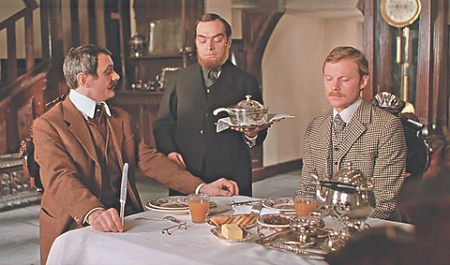
To an article about oats in Samuel Johnson’s dictionary of 1775 (“Oats are a grain that is usually fed to horses in England, but people eat it in Scotland”), one of the Scottish wits of the time reacted as follows: “That is why fine horses are raised in England, and fine people in Scotland.”
Modern Scots know the definition of porridge in the explanatory dictionary of the Russian language in 1995 (“Porridge. The traditional breakfast of the British is oatmeal porridge”), they would hardly agree with him: the Scots (descendants of the Celts) do not consider themselves English (descendants of the Anglo-Saxons). Apart from the fact that the bridge appeared in Scotland, not in England.
But let’s not delve into the history of the origin of peoples and the formation of nations in the British Isles and where they differ from each other (this can lead quite far). And let’s turn to the history of oatmeal porridge, because porridge is the real oatmeal porridge. And it’s not at all the one we’ve been used to since childhood.
Health and endurance
Oats grew well in cold, humid climates and have been the staple and healthy food of the Scottish people since time immemorial. Not only simple, but also aristocratic families.
It is not known whether they were familiar in Scotland with the statement of Pliny, who claimed that oatmeal porridge was cooked and eaten with pleasure by the ancient Germans. But it was for the Scots, and not for the Germans, that oats, along with whiskey and kilt, became a symbol of national identity – from time immemorial, parkin tortillas were baked from it, skirlie was stewed with its participation, desserts were prepared and even added to alcohol.
The porridge was served in a small wooden bowl, and this bowl was so satisfying that both the hard workers and the lords forgot about the food until lunch. And the Scots (like the English now), who adhere to culinary traditions, continue to eat their traditional porridge in the morning to this day. The name of which culinary historians trace back to the Latin porrum – leek.
The national pride of the Scots increased immeasurably and convinced them of the right choice when, in the middle of the 19th century, Frank Buckland, chief adviser to the British army, announced urbi et orbi that after research he had come to the conclusion that Scottish soldiers who had been fed oatmeal since childhood were much healthier and more resilient than English soldiers.
How to make a real porridge
Very simple.
To make a real porridge, you need to boil water or water with milk. Slowly pour the oatmeal into a saucepan (two and a half tablespoons per half liter of water) and stir it constantly with a long wooden spoon (clockwise). When the water boils again, reduce the heat, cover and cook for 15 minutes. Add salt to taste and cook for another 5-10 minutes, depending on the quality of the oatmeal. In any case, do not add sugar or syrup. Just salt. This is a prerequisite.
Following all these simple rules, as a result you will get a thick and at the same time viscous porridge of uniform consistency.
This is the real porridge.
And what about Russia?
Russia is not far from Scotland in terms of oats: peasants and landowners have always valued oats for their useful properties. But both landlords and the same peasants approached its use utilitarianly, without any special gastronomic delights – they preferred to grind rather than grind grain. Bread was baked from the resulting flour (oatmeal) and a delicious and healthy porridge was cooked.
The well-known brand “Hercules” appeared before 1917 and was popular with residents of the vast country. When the Russian Empire turned into the Soviet One, new technologists picked up the old proven brand, but over time, excellent Russian porridge turned into Soviet “Herculean” porridge, which was fed to unhappy children in kindergartens, schools and pioneer camps.
In those days, a sturdy, rosy-cheeked kid with a spoon was smiling at you from a box of Hercules, showing with all his appearance how good this porridge was for him. Nowadays, you are being watched by a glamorous young man with a scythe and a similarly painted young woman with a basket (“Hercules” traditional) or a glamorous monk with a staff and a lad with a bowl (“Hercules” monastic) in the style of a la Russe. Which obviously suits the taste of today’s designers and marketers, who are not far removed from the Soviet ones.
People have nowhere to go, and those who prefer domestic products take what they have. Well, the modern food industry does not stand still (which is natural): New brands have appeared, and all kinds of spices, honey, nuts, dried berries and fruits have been added to oatmeal.
But porridge with additives is not porridge, and certainly not porridge.
P.S. Only the benefits
Easily digestible fiber contributes to the normal functioning of the gastrointestinal tract.
Oatmeal helps fight stress and depression.
Inositol contained in oats (an organic compound that belongs to the vitamin B group) lowers cholesterol levels and prevents the formation of cholesterol plaques.
Oatmeal improves the functioning of the endocrine system, helps to monitor weight, controls appetite.
A low glycemic index (an indicator of the effect of food on blood sugar levels) after eating allows people with diabetes to consume oatmeal.
Oatmeal contains calcium and phosphorus, which are essential for teeth and bones.
Eat to your heart’s content!
